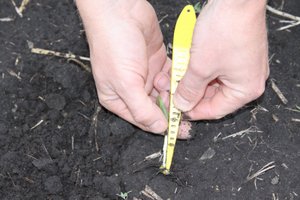Ever heard of road rage? Sure you have. It’s a term used to describe the emotionally generated aggressive and angry behavior of a driver. This conduct can include rude gestures, verbal insults, deliberately driving in an unsafe manner or making personal threats to others on the road. Road rage can lead to altercations, assaults and collisions, which may result in injuries or even deaths. It can be thought of as an extreme case of antagonistic driving or, more accurately, driving without rational, logical purpose.
Rage simply results in loss of control, which is what happens when emotions and tempers flare on the road. Fury, on the other hand, means destructive rage, verging on madness, which better describes what’s been happening in farm fields all across the country this year. We call this Fall Field Fury.
Fall Field Fury occurs when growers unwittingly take their anger and frustrations out on the very fields they just finished harvesting. As with any level of rage, rational thinking is overtaken by thoughtless, spontaneous actions, which are most often diametrically opposed to achieving the desired goal. In the case of road rage, the original goal is to reach your destination but the actual outcome becomes adverse or destructive and may include ending up in a ditch or even jail. In the case of Fall Field Fury, the real objective is to achieve next year’s yield goal, but the result is likely to be anything but that if you lose sight of your purpose and the intended goal.
Many farmers were frustrated throughout the season as they watched their crops get pummeled by every kind of environmental event possible. That kind of frustration was amplified since memories of above-normal yields from previous years were not very far away. All of those disappointments seem to have converged, placing many farmers into a state of Fall Field Fury. That is, they inadvertently began taking their frustrations out on their own fields—including implementing tillage or fertility practices that made no real sense. They began unknowingly damaging their chances of maximizing yields in 2012.
We see farmers using deep ripping, thinking it will solve compaction issues. However, this year is less about compaction and much more about “baked” soils—soils that are very hard and compressed from excessive heat and dry weather. In years when soils are moist, it may have made sense to deep rip soils to break up hard pans, but with soils this dry and hard, the only thing that relieves this baked condition is added moisture and frost. We see anhydrous ammonia being applied at rapid rates with only one thought in mind— getting the fall fertilizer applied before the weather gets bad. Although, applying anhydrous ammonia in these kinds of soil conditions simply cannot be justified.
We see the moldboard plow ever-present in many areas this year. These growers seem desperate, as they want to solve problems in their fields, although they are going about it in the wrong way. As their fathers and grandfathers did, they continue to believe that moldboard plowing kills insects and helps control diseases, but this cannot be used as a yield-building strategy. In highly drained soils like ours, which are already short on moisture, moldboard plowing only makes matters worse. It simply dries the soil out, rather than conserving moisture needed for microbial activity, residue breakdown and erosion reduction. Farmers need to look at and examine their entire crop production system whenever they decide to execute any specific production element.
Many growers are experiencing Fall Field Fury right now. They’re in their fields doing things that will negatively affect their ability to raise top yields in 2012. Rather than focusing on the tactics geared toward raising a better crop in 2012, they are too busy trying to figure out how to get their farming finished and out of way while the fall weather holds.
This is the time of the year when every farmer needs to do two things. First, summarize and analyze everything he learned on the combine this year. Second, match that knowledge with his future yield goal plans. Nothing can derail your real objectives faster than doing things that get you off track, rather than focusing on what it takes to achieve those goals. Make sure to control your emotions this year and don’t let Fall Field Fury affect your plans to raise the best crop you ever raised, next year.
 How do you minimize the damage from the more than 1,000 variables that affect the intended performance of every crop? Follow these top 5 factors. It is YOUR key to Protecting Product Performance. See how many you remember.
How do you minimize the damage from the more than 1,000 variables that affect the intended performance of every crop? Follow these top 5 factors. It is YOUR key to Protecting Product Performance. See how many you remember.



 Crop monitoring has always been an important part of raising top yields. That’s why keeping day to day tabs on what’s happening in growers’ fields not only protects yields, but supplies reams of information for future use. As farmers get larger and demand for their time increases, it becomes even more difficult, yet imperative, to have someone (or in this case, some
Crop monitoring has always been an important part of raising top yields. That’s why keeping day to day tabs on what’s happening in growers’ fields not only protects yields, but supplies reams of information for future use. As farmers get larger and demand for their time increases, it becomes even more difficult, yet imperative, to have someone (or in this case, some
